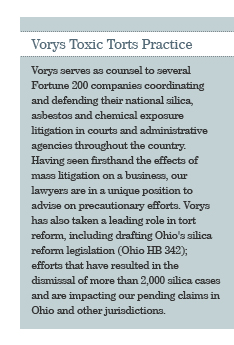Client Alert: NIOSH Studies Worker Exposure to Silica During Hydraulic Fracturing and Issues An Alert
 The Occupational Safety and Health Administration (OSHA), in collaboration with the National Institute for Occupational Safety and Health (NIOSH), has issued a "Hazard Alert" for the oil and gas industry regarding worker exposure to crystalline silica. The alert merits the attention of all who are involved with hydraulic fracturing operations.[1]
The Occupational Safety and Health Administration (OSHA), in collaboration with the National Institute for Occupational Safety and Health (NIOSH), has issued a "Hazard Alert" for the oil and gas industry regarding worker exposure to crystalline silica. The alert merits the attention of all who are involved with hydraulic fracturing operations.[1]
Crystalline silica that is small enough to be respirable can cause chronic or classic silicosis. Silicosis is a progressive disease that may not manifest itself for 10-20 years after exposure. Higher levels of exposure can cause accelerated and/or acute silicosis in shorter time periods. The International Agency for Research on Cancer (IARC) has classified respirable crystalline silica as carcinogenic, as causing lung cancer in humans.
Samples Collected at Worksites Show Exposure
As a part of its study, NIOSH collected 116 samples from hydraulic fracturing worksites in five states (Arkansas, Colorado, North Dakota, Pennsylvania and Texas) to determine the levels of worker exposure to respirable crystalline silica. NIOSH reports that "many" air samples showed silica levels above defined occupational exposure limits. Significantly, NIOSH found 47% of the samples were above the OSHA PEL ("permissible exposure level" under the OSHA regulations) and 79% were above the lower NIOSH REL ("recommended exposure level") of 0.05 milligrams per cubic meter. While the recommended exposure level is not the legally enforceable regulatory limit, the alert notes that "both OSHA and NIOSH recommend that employers take actions to keep work exposures below the NIOSH REL (emphasis added)." OSHA and NIOSH have been investigating worker safety and health hazards related to oil and gas extraction. OSHA intends to keep a close eye on this growing industry.
NIOSH Recommends Ways to Limit Exposure
NIOSH identified the sources of silica dust exposure as including the loading and ejecting of the sand from transportation vehicles, sand movers, blender hoppers and transfer belts. OSHA and NIOSH suggest engineering controls, work practices, protective equipment and product substitution to help control worker exposure. Additional in-depth information on controlling silica exposure may be found at the OSHA-NIOSH Hazard Alert at www.osha.gov.
The alert is not a standard or regulation and it creates no new legal obligations. It is, however, a reminder that the Occupational Safety and Health Act requires employers to provide workers with a workplace "that is free from recognized hazards that are causing or are likely to cause death or serious physical harm" to workers. We recommend that operators and producers review the alert to learn more about (1) the hazards of silica exposure and (2) proactive steps that may be taken to reduce employee exposure.
For more information on these developments, please contact your Vorys attorney. Read more about the firm's toxic tort and workplace safety practices.
[1] OSHA is the regulatory agency responsible for ensuring that employers provide safe workplaces; NIOSH is an independent agency which conducts scientific research, develops guidance and recommendations and provides information regarding how employers can provide safe workplaces.


